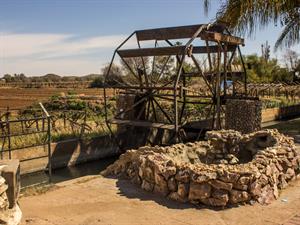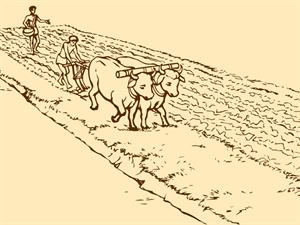
PUMPA - SMART LEARNING
எங்கள் ஆசிரியர்களுடன் 1-ஆன்-1 ஆலோசனை நேரத்தைப் பெறுங்கள். டாப்பர் ஆவதற்கு நாங்கள் பயிற்சி அளிப்போம்
Book Free DemoAgriculture - the lifeline of Indian Economy:
As a country that is highly dependent on natural resources, India's primitive settlers performed Agricultural functions on the banks of Rivers to enhance their livelihood.

Ancient Persian Wheel
Rural India was the fulcrum of agricultural production in India. The Tughlaq ruler Firoz Tughlaq showed keen interest in promoting agriculture and enhancing the lives of peasants by waving their debts.
Firoz Tughlaq: He was a ruler of the Tughlaq dynasty who showed great commitment to building canals and tanks to promote irrigation. The largest network of canals in India was built during his period.
Empires across India supported agriculture which also functioned as a great source of revenue as the produces were taxed by the rulers. They also constructed huge check dams for the storage of water.
Vativayakkal: These are water channels constructed in North-South and in the East-West direction, which is used to collect water from the deltas. These were found during the rule of the Pallava dynasty.
The Persian wheels, which are mechanized water drawing instruments employed to draw water from wells and tanks, are widely found in North India.
Agricultural produces in India:
The people of Medieval India were well aware of cropping seasons and methodologies, which allowed them to cultivate various crops.
Most of the crops were cultivated for livelihood and were imported to local markets, which were exchanged between people of various regions.

Agriculture in India
Crops like Rice, Wheat, Millets and Grams were cultivated according to the seasons and the soil fertility. Commercial crops like Sugarcane were also cultivated.
Vegetable and fruit cultivation gained prominence along with commercial crops after the arrival of Western people.
Commercialisation of Agriculture:
After Europeans' arrival, Agriculture in India took a new turn where commercialisation of Agriculture took place. Production of staple crops witnessed a decline, and commercial crops like Indigo, Maize, Cotton and Tobacco increased.
The Growth of Crafts in India:
The skilled workers also contributed to the growth of the economy by producing finished goods and crafts which are sold in local markets. Pottery, Woodworks, and Sculpture making some of the fine arts that were performed during the medieval period.
Kharknas: These are Royal workshops established by the Sultans of Delhi Sultanate, where thousands of slaves were used for construction purposes.